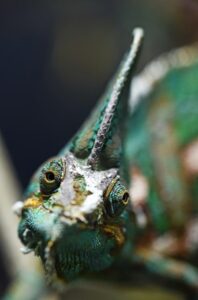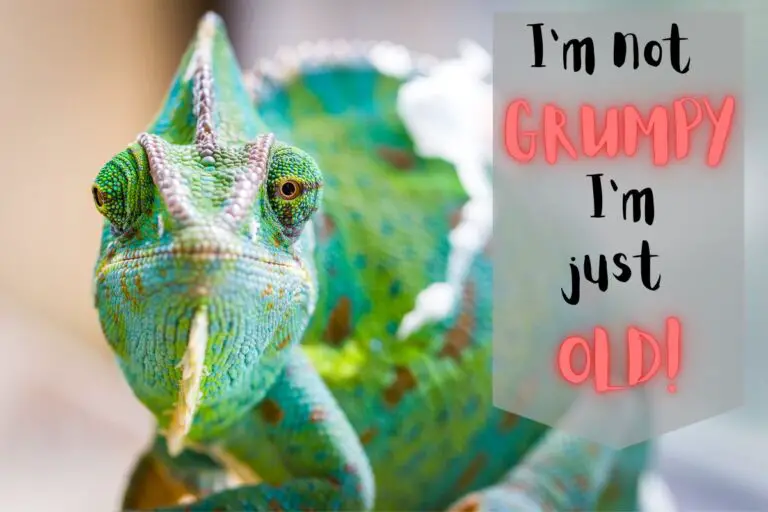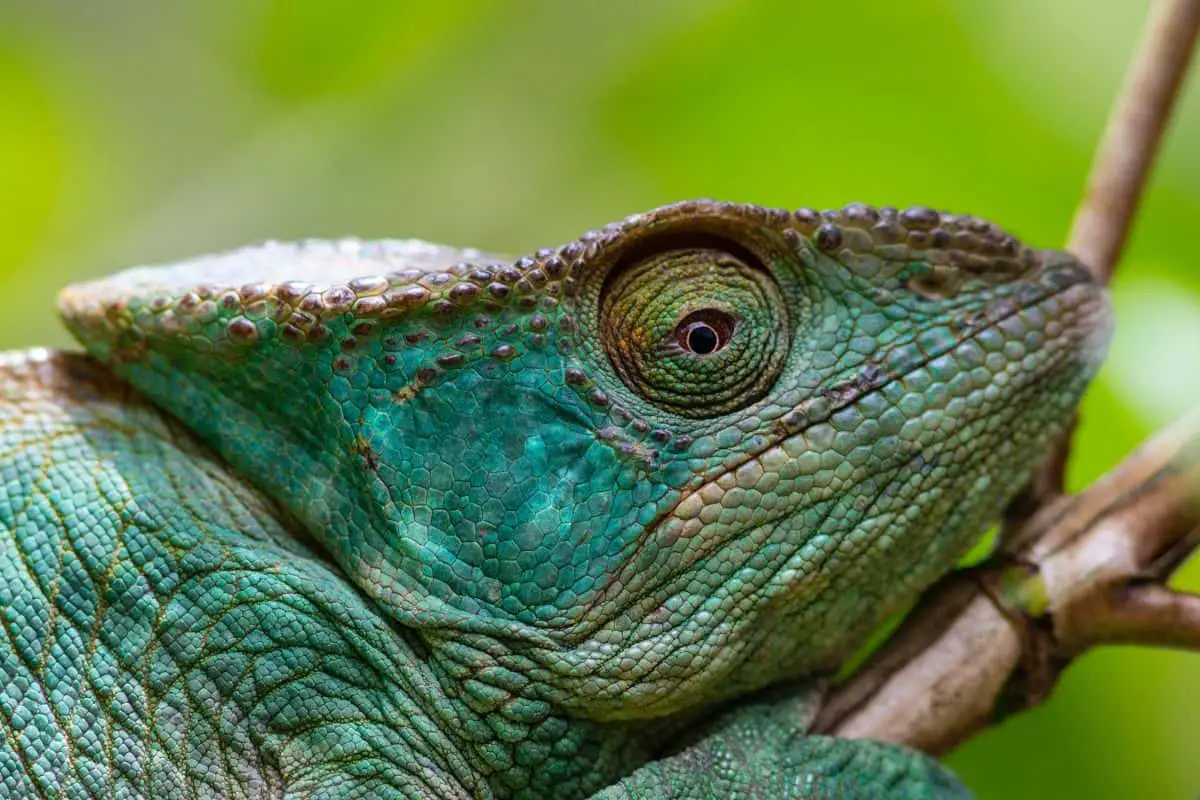How Long Do Chameleons Live? Popular Species’ Lifespans
How long do chameleons live? …and is there anything we can do to increase our pet chameleon’s longevity and lifespan?
Depending on the species, chameleon lifespan can vary greatly. For example, carpet chameleons live an average of 2 years whereas Parson’s chameleons can live nearly 20 years! Most chameleon species live an average in between those extremes; 5 to 10 years.
Though chameleons can live for a decade or more, the word “can” has important connotation. Well cared for and healthy chameleons can live long lives, but it’s a sad fact that many pet chameleons DO NOT.
Many chameleons sold and kept as pets, live pathetically (and depressingly) short lives. Parasite and disease riddled wild-caught specimens and poor husbandry by uneducated chameleon owners DRASTICALLY shorten countless chameleons’ lives!
Reptile Roommate is a participant in the Amazon Services LLC Associates Program. As an Amazon Associate I earn from qualifying purchases.
Chameleon Lifespan The Wild vs Captivity
In the wild most chameleons have a two to three year lifespan.
Predators, parasites and disease, as well as environmental pressures like climate and deforestation, all serve to reduce the number of years chameleons live.
In captivity however, chameleons no longer face pressures from predators and environmental stress (given proper care) and parasites, infection and disease can be fought with medication and veterinarian care.
Captive chameleons also have (or definitely should have) access to the best and most complete nutrition available, again maximizing the potential for a long,(er) happy life!

Chameleon Lifespan; What Can Go Wrong?
Wild caught chameleons can present a host of problems for keepers.
Most often wild caught chameleons come from countries far across the globe and endure long travel times, very often without food, proper temperature, and even without water!
Chameleons are routinely “packaged” in bags with numerous other chameleons.
Wild caught chameleons are very often so dehydrated that they are near death. Those that do make it to their destination sometimes never recover from the experience.
Unfortunately, a majority of wild caught animals contain parasites and have injuries sustained from either collection or transport.
Not only are the captured chameleons put in danger, but so is the chameleon population in their native countries.
Regrettably, many pet chameleons (both wild caught and captive bred) suffer the same high mortality rates that chameleons do in the wild. In many cases it can be even worse!
There is a very unfortunate “disposable pet” attitude prevalent in some would be pet owners. Some people view the death, poor health and purported “short lifespan” of chameleons as “normal.”
Chameleons in poor health and suffering from mistreatment is nothing close to normal.
Chameleons are also more demanding reptiles, especially for beginners. Not only can they be expensive to purchase but their enclosure, care and upkeep can be demanding as well.
This doesn’t make chameleons bad pets; to the contrary!
Chameleons can make excellent pets for those educated in their care requirements and those willing to take on the responsibility of keeping such an animal.
If you’d like to find out if a chameleon might be the right pet for you, please check out our discussion regarding whether chameleons make good pets for beginners.
Average Captive Lifespan: Species Breakdown
note: “average lifespan” is based on quality care and excellent husbandry along with the proper medical attention when needed
- Jackson’s chameleon 6 to 10 years
- Veiled Chameleon 6 to 8+ years
- Panther chameleons 3 to 6+ years
- Carpet chameleons 2 to 3 years
- Fischer’s chameleon 3 to 5 years
- Parson’s chameleon 10 to 20 years
- Meller’s chameleon 8 to 12 years
- Senegal Chameleon 3 to 5 years

Fact: | The Labord’s chameleon has the record for the shortest lifespan of all four-legged animals at 4-5 months!
Chameleon Growth; Baby to Adult at Breakneck Speed
The environmental and predatory pressures on chameleons in the wild result in a relatively short lifespan, as such chameleons are quick to develop and reach sexual maturity.
In under a year most chameleons grow from just babies to adult size and are able to breed. (although many chameleons will continue to grow slowly for an additional two or so years)
For example a veiled chameleon can go from a 1 gram hatchling to over 220 grams in less than 12 months.
Chameleons definitely “live fast” in a race to reproduce and keep the species going.
Maximizing Chameleon Husbandry For Longevity
Providing your pet chameleon with the environment that it needs and a healthy diet has a direct effect on it living a long life!
Environment For Success
Many chameleons (panther, veiled, etc) are quite large, tree-dwelling species. (Meller’s chameleons can reach up words of 2 feet!) As such they need equally large enclosures.
Chameleons need areas to climb, drink from and feel secure inside their enclosure. Large, heavy-bodied plants with thick leaves or even trees like ficus make great climbing structures.
Chameleons also need branches, vines and other climbing structures in their habitats.
Due to a chameleon’s size and the need to have space for the large plants/trees/foliage that they require, a chameleons enclosure must take into account these needs and be sized accordingly.
A 3ft x 3ft x 4ft tall make great habitats for larger chameleon species. Smaller chameleons (notably carpet and pygmy chameleons) can utilize habitats in the range of 18” x 18” x 30.”
MORE space is always better!
Your chameleons enclosure will also need to feature a basking area, UVA/UVB lighting and space for temperature gradients between 70-80° on the cool side and between 80 – 100° (dependent on species)
In order to provide your chameleon with the necessary humidity levels it needs, many habitats will require a fogger, automatic misting system or drip system.
Providing a Healthy Diet For Long-Lived Chameleons
Chameleons are mostly carnivorous and need a steady diet of insects to thrive. In captivity crickets, roaches, superworms and mealworms (fed in moderation) are staples of a chameleon’s diet.
Insects should be gut loaded by feeding them high quality sources of leafy greens and dusted with calcium and vitamin supplements.
Certain chameleon species will occasionally eat leafy greens and vegetables when offered.
Chameleons do NOT drink water from bowls or dishes. Chameleons drink drops of water from leaves and vegetation, made possible by drip/misting systems slowly dripping water on the plants and leaves in their enclosure.
Neglecting a chameleons need for quality food or not providing appropriate drinking opportunities will absolutely have a detrimental effect on your chameleon’s health and longevity

Chameleon Disease, Health Issues and Preventive Care
Chameleons can be susceptible to infections and disease especially when not taken care of properly.
You can help to keep bacterial and fungal infections at bay by properly cleaning and disinfecting your chameleons enclosure and by removing waste and uneaten food.
If your chameleon was wild caught, it will definitely need a visit to the veterinarian as soon as possible given the fact that most chameleons from the wild have parasites.
Chameleons are also sensitive to household items such as cleaning supplies and aerosols.
Chameleons can Suffer from a number of medical problems such as MBD or metabolic bone disease, (causes include lack of calcium in diet) dehydration, gout, (caused by too much protein in their diet) and mouth rot.
Respiratory and skin infections, vitamin A deficiency and more are all compounded by poor husbandry and lack of education in the proper care that these reptiles need.
Regular veterinarian visits may be a part of your chameleons life; please have a plan for that!
These are some symptoms that you should be aware of and have addressed as soon as possible;
- Diarrhea –can indicate parasites, bacterial infection, or poor husbandry in regards to temperature.
- Injury or damage to legs and extremities –causes can include low calcium levels or gout
- Falling or losing grip of branches and plants –these serious symptoms need to be addressed immediately and can be signs of MBD (metabolic bone disease)
- Sleeping during daylight hours –your chameleon could be stressed due to poor husbandry or other issues
Chameleons can suffer from many ailments and can be somewhat fragile.
As a chameleon keeper we need to be committed to providing the best environment, care, and nutrition to our chameleons so that they can live long lives in our care.
How Long Do Chameleons Live? It Depends On You!
Captive chameleons kept as pets can have their lifespans significantly improved over their wild cousins.
Or at least that’s how it should be!
Unfortunately, because of the prevalence of wild caught specimens and chameleons kept in subpar conditions many captive chameleons actually live SHORTER lives than they would have in the wild.
How long chameleons can live (in captivity) has more to do with us as reptile keepers than a between “x to y years” average you’ll find by Googling for an answer.
Chameleon lifespan is highly dependent on us!


